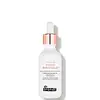What's inside
What's inside
 Key Ingredients
Key Ingredients

 Benefits
Benefits

 Concerns
Concerns

 Ingredients Side-by-side
Ingredients Side-by-side

Zinc Oxide 20.5%
Cosmetic ColorantBentonite
AbsorbentBisabolol
MaskingButyloctyl Salicylate
Skin ConditioningCaprylhydroxamic Acid
Capryloyl Glycerin/Sebacic Acid Copolymer
Skin ConditioningCaprylyl Glycol
EmollientCarthamus Tinctorius Oleosomes
EmollientCetearyl Alcohol
EmollientCitric Acid
BufferingDiheptyl Succinate
EmollientGalactoarabinan
Glycerin
HumectantGlyceryl Caprylate
EmollientGlyceryl Stearate Citrate
EmollientJojoba Esters
EmollientPolyhydroxystearic Acid
EmulsifyingRubus Idaeus Seed Oil
EmollientSodium Stearoyl Glutamate
CleansingTocopherol
AntioxidantWater
Skin ConditioningZinc Oxide 20.5%, Bentonite, Bisabolol, Butyloctyl Salicylate, Caprylhydroxamic Acid, Capryloyl Glycerin/Sebacic Acid Copolymer, Caprylyl Glycol, Carthamus Tinctorius Oleosomes, Cetearyl Alcohol, Citric Acid, Diheptyl Succinate, Galactoarabinan, Glycerin, Glyceryl Caprylate, Glyceryl Stearate Citrate, Jojoba Esters, Polyhydroxystearic Acid, Rubus Idaeus Seed Oil, Sodium Stearoyl Glutamate, Tocopherol, Water
Water
Skin ConditioningIsododecane
EmollientPolyglyceryl-6 Polyricinoleate
EmulsifyingPropanediol
SolventDimethicone
EmollientCaprylic/Capric Triglyceride
MaskingTrimethylsiloxysilicate
EmollientButyloctyl Salicylate
Skin ConditioningCoco-Caprylate/Caprate
EmollientIsoamyl Laurate
EmollientNeopentyl Glycol Diheptanoate
EmollientPolyglyceryl-10 Dioleate
EmulsifyingLecithin
EmollientPolyhydroxystearic Acid
EmulsifyingEctoin
Skin ConditioningPolymethylsilsesquioxane
Polysilicone-11
Disteardimonium Hectorite
StabilisingButyrospermum Parkii Butter
Skin ConditioningGlycerin
HumectantPhenoxyethanol
PreservativePropylene Carbonate
SolventAminomethyl Propanol
BufferingCitrus Aurantium Dulcis Peel Oil
MaskingEthylhexylglycerin
Skin ConditioningPolysorbate 20
EmulsifyingSclareolide
MaskingTocopheryl Acetate
AntioxidantDimethicone/Vinyl Dimethicone Crosspolymer
Skin ConditioningDimethiconol
EmollientLinalool
PerfumingLinalyl Acetate
MaskingPlankton Extract
Skin ConditioningLavandula Angustifolia Oil
MaskingLavandula Hybrida Oil
EmollientDecyl Glucoside
CleansingSodium Ascorbate
AntioxidantCaprylyl Glycol
EmollientHexylene Glycol
EmulsifyingTocopherol
AntioxidantWater, Isododecane, Polyglyceryl-6 Polyricinoleate, Propanediol, Dimethicone, Caprylic/Capric Triglyceride, Trimethylsiloxysilicate, Butyloctyl Salicylate, Coco-Caprylate/Caprate, Isoamyl Laurate, Neopentyl Glycol Diheptanoate, Polyglyceryl-10 Dioleate, Lecithin, Polyhydroxystearic Acid, Ectoin, Polymethylsilsesquioxane, Polysilicone-11, Disteardimonium Hectorite, Butyrospermum Parkii Butter, Glycerin, Phenoxyethanol, Propylene Carbonate, Aminomethyl Propanol, Citrus Aurantium Dulcis Peel Oil, Ethylhexylglycerin, Polysorbate 20, Sclareolide, Tocopheryl Acetate, Dimethicone/Vinyl Dimethicone Crosspolymer, Dimethiconol, Linalool, Linalyl Acetate, Plankton Extract, Lavandula Angustifolia Oil, Lavandula Hybrida Oil, Decyl Glucoside, Sodium Ascorbate, Caprylyl Glycol, Hexylene Glycol, Tocopherol
Ingredients Explained
These ingredients are found in both products.
Ingredients higher up in an ingredient list are typically present in a larger amount.
Butyloctyl Salicylate is a chemical UV filter structurally similar to octisalate. It is a photostabilizer, SPF booster, emollient and solvent. This ingredient helps evenly spread out ingredients.
According to a manufacturer, it is suitable for pairing with micro Titanium Dioxide, Zinc Oxide, and pigments.
Photostabilizers help stabilize UV-filters and prevents them from degrading quickly.
Learn more about Butyloctyl SalicylateCaprylyl Glycol is a humectant and emollient, meaning it attracts and preserves moisture.
It is a common ingredient in many products, especially those designed to hydrate skin. The primary benefits are retaining moisture, skin softening, and promoting a healthy skin barrier.
Though Caprylyl Glycol is an alcohol derived from fatty acids, it is not the kind that can dry out skin.
This ingredient is also used as a preservative to extend the life of products. It has slight antimicrobial properties.
Learn more about Caprylyl GlycolGlycerin is already naturally found in your skin. It helps moisturize and protect your skin.
A study from 2016 found glycerin to be more effective as a humectant than AHAs and hyaluronic acid.
As a humectant, it helps the skin stay hydrated by pulling moisture to your skin. The low molecular weight of glycerin allows it to pull moisture into the deeper layers of your skin.
Hydrated skin improves your skin barrier; Your skin barrier helps protect against irritants and bacteria.
Glycerin has also been found to have antimicrobial and antiviral properties. Due to these properties, glycerin is often used in wound and burn treatments.
In cosmetics, glycerin is usually derived from plants such as soybean or palm. However, it can also be sourced from animals, such as tallow or animal fat.
This ingredient is organic, colorless, odorless, and non-toxic.
Glycerin is the name for this ingredient in American English. British English uses Glycerol/Glycerine.
Learn more about GlycerinPolyhydroxystearic Acid is a soft wax made from castor oil.
It is is a texture thickener, emulsifier, and film-former. Emulsifiers prevent ingredients from separating, such as oils and waters.
Polyhydroxystearic Acid may not be fungal acne safe.
Learn more about Polyhydroxystearic AcidTocopherol (also known as Vitamin E) is a common antioxidant used to help protect the skin from free-radicals and strengthen the skin barrier. It's also fat soluble - this means our skin is great at absorbing it.
Vitamin E also helps keep your natural skin lipids healthy. Your lipid skin barrier naturally consists of lipids, ceramides, and fatty acids. Vitamin E offers extra protection for your skin’s lipid barrier, keeping your skin healthy and nourished.
Another benefit is a bit of UV protection. Vitamin E helps reduce the damage caused by UVB rays. (It should not replace your sunscreen). Combining it with Vitamin C can decrease sunburned cells and hyperpigmentation after UV exposure.
You might have noticed Vitamin E + C often paired together. This is because it is great at stabilizing Vitamin C. Using the two together helps increase the effectiveness of both ingredients.
There are often claims that Vitamin E can reduce/prevent scarring, but these claims haven't been confirmed by scientific research.
Learn more about TocopherolWater. It's the most common cosmetic ingredient of all. You'll usually see it at the top of ingredient lists, meaning that it makes up the largest part of the product.
So why is it so popular? Water most often acts as a solvent - this means that it helps dissolve other ingredients into the formulation.
You'll also recognize water as that liquid we all need to stay alive. If you see this, drink a glass of water. Stay hydrated!
Learn more about Water